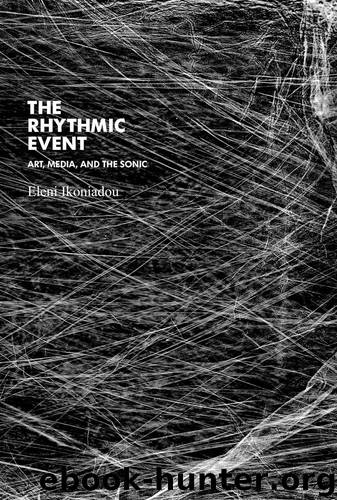The Rhythmic Event by Ikoniadou Eleni

Author:Ikoniadou, Eleni [Ikoniadou, Eleni]
Language: eng
Format: epub
Tags: New Media Theory, Philosophy, Art Criticism and Theory, Acoustics and Sound
ISBN: 9780262027649
Publisher: MIT Press
Published: 2014-05-02T16:00:00+00:00
Figure 2.5
Marie Sester, ACCESS. Courtesy of the artist.
ACCESS submerges bodies under its spotlight, surrounding them in an involuntary ultrasonic space. Its purpose seems to be to produce a field of intensive audio forces that shock the bodies that pass through them. On one level, the spotlight adjusts its speeds and rhythms to the actual movements of the body, immersing it in the brightness of its beam. The spotlight’s intensity is designed to envelop the body’s movement entirely, becoming one with it, making their separation impossible until a new movement “grabs” its attention. Motion-tracking algorithms are programmed to capture the movement of a body in the form of a granular moving swarm. The camera sees a population of grains forming a sticky blob: when two bodies (swarm clouds) come into contact or close proximity, the program might leave one body for another—Audio Spotlight as digital contagion.
On another level, at first glance the device may appear in full control, targeting bodies indiscriminately across its spatial territory and for an indeterminate amount of time. Nevertheless, its process of contagion casts the target in a more dynamic role. Participants engaging with the installation provoke the spotlight by seeking contact with other bodies and attempting to lure it toward or away from them. With one move, a body comes out of the shadows and is captured by the grid; a moment later it becomes undetectable, falling back into the darkness from which it emerged. Following on the angle of contagion, interactivity takes the form of a viral entity rather than a unidirectional reflexive process. As targeted bodies slip in and out of ACCESS’s indeterminate zones, they become potential carriers of audiovisual forces, interacting virally with other bodies and with the machine, with no regard for the spotlight’s intrinsic tendencies toward directionality and control.
Occasionally, being caught in the installation’s web might signal a state of audio hallucination, a feeling that the sound derives from inside one’s head. Deceptively autogenerated, the voices puzzle a targeted body, intensifying its feeling of disorientation conveyed by the floodlight. The targets become unsure whether they are the only ones to hear these voices, akin to those that haunt and confuse hallucination sufferers. Often the messages they transmit may take the shape of commands, instructing targets toward specific actions. On the verge between inner command and external influence, hallucination and reality, confusion and control, the affected body is thrown into doubt: should it try to escape or obey; run or fight? Is it being invaded by an alien danger, or is its inner sensation—the contraction of its own perception—in the position of contaminating the outside? The targeted body’s capacity to affect and be affected by the audio spotlight in a process of “rhythm and contortion” appears renewable. The “hide and seek” situation can be repeated endlessly, and the target may assume the role of hunter, or may succeed in escaping the machine. Every time the process restarts, all the elements of the assemblage fall back into uncertainty.
ACCESS seems
Download
This site does not store any files on its server. We only index and link to content provided by other sites. Please contact the content providers to delete copyright contents if any and email us, we'll remove relevant links or contents immediately.
Cecilia; Or, Memoirs of an Heiress — Volume 1 by Fanny Burney(32091)
Cecilia; Or, Memoirs of an Heiress — Volume 3 by Fanny Burney(31481)
Cecilia; Or, Memoirs of an Heiress — Volume 2 by Fanny Burney(31435)
The Great Music City by Andrea Baker(30930)
We're Going to Need More Wine by Gabrielle Union(18663)
All the Missing Girls by Megan Miranda(14852)
Pimp by Iceberg Slim(13828)
Bombshells: Glamour Girls of a Lifetime by Sullivan Steve(13718)
Fifty Shades Freed by E L James(12936)
Talking to Strangers by Malcolm Gladwell(12916)
Norse Mythology by Gaiman Neil(12879)
For the Love of Europe by Rick Steves(11661)
Crazy Rich Asians by Kevin Kwan(8912)
Mindhunter: Inside the FBI's Elite Serial Crime Unit by John E. Douglas & Mark Olshaker(8750)
The Lost Art of Listening by Michael P. Nichols(7190)
Enlightenment Now: The Case for Reason, Science, Humanism, and Progress by Steven Pinker(6891)
The Four Agreements by Don Miguel Ruiz(6343)
Bad Blood by John Carreyrou(6295)
Weapons of Math Destruction by Cathy O'Neil(5871)
